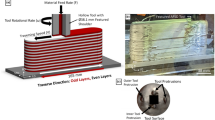Abstract
The impact of friction stir processing (FSP) on the structure and mechanical properties of the age-hardenable aluminum casting alloy A206 was investigated. FSP nearly eliminated the solidification shrinkage porosity present in the as-cast condition. FSP significantly increased both the strength and tensile ductility of cast A206 alloy. When applied to A206 that had previously been solution-heat-treated and aged, FSP resulted in a more moderate increase in strength; however, ductility was notably increased. A206 that had been subjected to FSP was found to respond to artificial aging treatment. Fatigue resistance was also found to be significantly enhanced in A206 after FSP. The entire S–N curve is favorably shifted after FSP, and more importantly, fatigue strength at 108 cycles nearly doubled from about 85.5 MPa in the as-cast condition to 165 MPa. These results point to FSP as an effective way to locally enhance the mechanical properties of cast Al components.











Similar content being viewed by others
References
W.M. Thomas, E.D. Nicholas, J.C. Needham, M.G. Murch, P. Templesmith, C.J. Dawes, G.B. Patent Application No. 9125978.8, 1991
Z.Y. Ma, Friction stir processing technology: a review. Metall. Mater. Trans. A 39, 642–658 (2008)
P. Cavaliere, P.P. De Marco, Friction stir processing of a Zr-modified 2014 alloy. Mater. Sci. Eng. A 462, 206–210 (2007)
P. Cavaliere, A. Squillace, High temperature deformation of friction stir processed 7075 aluminium alloy. Mater. Charact. 55, 136–142 (2005)
P. Cavaliere, Effects of friction stir processing on the fatigue properties of a Zr-modified 2014 alloy. Mater. Charact. 57, 100–104 (2006)
N. Sun, D. Apelian, Friction stir processing of Al cast alloys for high performance applications. J. Met. Mater. Miner. 63, 44–50 (2011)
R.S. Mishra, M.W. Mahoney (eds.), Friction Stir Welding and Processing (ASM International, Materials Park, 2007)
Y.J. Kwon, N. Saito, I. Shigematsu, Friction stir process as a new manufacturing technique of ultrafine grained aluminum alloy. J. Mater. Sci. Lett. 21, 1473–1476 (2002)
D.C. Hofmann, K.S. Vecchio, Submerged friction stir processing (SFSP): an improved method for creating ultra-fine-grained bulk materials. Mater. Sci. Eng. A 402, 234–241 (2005)
Z.Y. Ma, R.S. Mishra, Development of ultrafine-grained microstructure and low temperature (0.48 Tm) superplasiticity in friction stir processed Al–Mg–Zr. Scr. Mater. 53, 75–80 (2005)
I. Charit, R.S. Mishra, High strain rate superplasticity in a commercial 2024 Al alloy via friction stir processing. Mater. Sci. Eng. A 359, 290–296 (2003)
I. Charit, R.S. Mishra, Low temperature superplasticity in a friction-stir-processed ultrafine grained Al–Zn–Mg–Sc alloy. Acta Mater. 53, 4211–4223 (2005)
Z.Y. Ma, F.C. Liu, R.S. Mishra, Superplastic deformation mechanism of an ultrafine-grained aluminum alloy produced by friction stir processing. Acta Mater. 58, 4693–4704 (2010)
M. Mahoney, C. Fuller, M. Miles, W. Bingel, Thick plate bending of friction stir processed aluminum alloys, in Friction Stir Welding and Processing III, ed. by K. Jata, M. Mahoney, R. Mishra, T. Lienert (TMS, Pittsburgh, 2005), pp. 131–137
Z.Y. Ma, S.R. Sharma, R.S. Mishra, Microstructural modification of as-cast Al–Si–Mg alloy by friction stir processing. Metall. Mater. Trans. A 37, 3323–3336 (2006)
Z.Y. Ma, S.R. Sharma, R.S. Mishra, Effect of friction stir processing on the microstructure of cast A356 aluminum. Mater. Sci. Eng. A 433, 269–278 (2006)
X. Zhu, Ultrasonic fatigue test of E319 cast aluminium alloy in the long lifetime regime. Dissertation for the degree of Doctor of Philosophy, University of Michigan, 2007
H. Mayer, Fatigue crack growth and the threshold measurements at very high frequencies. Int. Mater. Rev. 44, 1–34 (1999)
X. Zhu, J. Yi, J.W. Jones, J. Allison, Effect of frequency and environment on room temperature fatigue performance of E319 cast aluminum alloy, in Fourth International Conference on Very High Cycle Fatigue (VHCF-4), ed. by J.E. Allison, J.W. Jones, J.M. Larsen, R.O. Ritchie (TMS (The Minerals, metals & Materials Society), Pittsburgh, 2007), p. 429
S. Jacob, Quality index in prediction of properties of aluminum castings—a review. AFS Trans. 108, 99–208 (2000)
D.A. Porter, K.E. Easterling, M.Y. Sherif, Phase Transformations in Metals and Alloys, 3rd edn (CRC, 2009), pp. 277–279
ASM Handbook, Volume 4, Heat treating (ASM International, 1991)
W.J. Dixon, A.M. Mood, A method for obtaining and analyzing sensitivity data. J. Am. Stat. Assoc. 43, 109–126 (1948)
Metallic materials: fatigue testing—statistical planning and analysis of data, ISO 12107: 2012 (E)
S.-K. Lin, Y.-L. Lee, M.-W. Lu, Evaluation of the staircase and the accelerated tests for fatigue limit distributions. Int. J. Fatigue 23, 75–83 (2005)
Y.X. Gao, J.Z. Yi, P.D. Lee, T.C. Lindley, A micro-cell model of the effect of microstructure and defects on fatigue resistance in cast aluminum alloys. Acta Mater. 52, 5435–5449 (2004)
J.Z. Yi, P.D. Lee, T.C. Lindley, Microstructure-based fatigue life prediction for cast A356-T6 aluminum-silicon alloys. Metall. Mater. Trans. B 37, 301–311 (2006)
D.A. Lados, D. Apelian, J.K. Donald, Fatigue crack growth mechanisms at the microstructure scale in Al–Si–Mg cast alloys: mechanisms in the near-threshold regime. Acta Mater. 54, 1475–1486 (2006)
Acknowledgements
The authors gratefully acknowledge the member companies of the Advanced Casting Research Center (ACRC) for their support of this work and for their continued support of research focused on the science and technology of metal casting at Worcester Polytechnic Institute.
Author information
Authors and Affiliations
Corresponding author
Rights and permissions
About this article
Cite this article
Sun, N., Jones, W.J. & Apelian, D. Friction Stir Processing of Aluminum Alloy A206: Part II—Tensile and Fatigue Properties. Inter Metalcast 13, 244–254 (2019). https://doi.org/10.1007/s40962-018-0268-6
Published:
Issue Date:
DOI: https://doi.org/10.1007/s40962-018-0268-6




